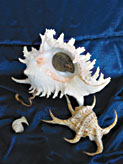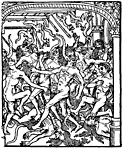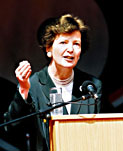On campus
Shells cast spells
There's a story that in the 1800s in Denmark, the king was the sole possessor of a rare Conus gloriamaris shell. When another of its type came into the country to be auctioned off, he sent a lackey to outbid all others. When the king got his hands on the second gloriamaris, he held it aloft for his court to see. He then placed the rare shell beneath his heel and ground it into fragments, ensuring that he was still the only one to own such a deep-sea treasure.

Clockwise from top: Giant Eastern Murex (Murex fulvescens), Chiragra Spider conch (Lambis chiragra), Japanese Wonder shell (Thatcheria mirabilis), West Indian Worm shell (Vernicularia spirata)
Franco Boriero
You can see splendid examples of Conus gloriamaris at the Redpath Museum, plus many other even more spectacular shells, thanks to the generosity of Abe Levine, who donated his collection to the museum. The Redpath now has the best public collection of bivalves, gastropods, chitons and "elephant tusk" scaphopods in Canada.
There are fairy-green land snails and zigzag nerites (burgundy snails with bands of black and white scribbles found in the mangroves in the Southwest Pacific). Wonder at the patterns on cone shells: their triangles within triangles are analogous to fractal geometry, following mathematical sequences in their regularity.
You can learn as you marvel. Carrier shells attach smaller shells and pebbles to their back — one even has a glass sponge that rises like smoke. The cowries — called "jewels of the depths"— gleam because, when alive, the animal's mantle slides up over its shell like a turtleneck.
Abe Levine's shells are remarkable not only for their unblemished quality, but also for the "freaks." His spiny oyster is a brute at twice the normal size (it grew on a submarine that sank in 1942, and was found 30 years later). Such deviants of the mollusk world can broaden the known scope of the morphological possibilities of sea animals.
Hodgson Gallery on the second floor of the Museum, open Monday to Friday, 9--5 and Sundays, 1--5. For the official opening, Abe Levine will be giving a brief informal guided tour of the shell exhibit, Thursday, October 16, 2003, at 4 pm. Everyone is welcome to this free event, but please call 398-4086 ext. 4094 to RSVP.
Environments 'R' Us
Assessing the human element of the environmental movement will be at the heart of an upcoming conference, to be held at the Wyndham hotel October 16--18. More than 62 countries will be represented at the 2003 Open Meeting of the Human Dimensions of Global Environmental Change Research Community.
Peter Brown, former director of the McGill School of the Environment, and Marc Levy, Associate Director of CIESIN (Centre for International Earth Science Information Network, Columbia University) will co-chair this year's meeting. "The careful integration of natural and social science data and information is increasingly recognized as vital to scientific research and societal decision-making," says conference coordinator Jeanne Adeland. "It can be related to a wide range of pressing environmental issues."
Topics will include land use change, environmental security, industrial transformation and environmental economics.
Barbara Goebels, president of International Human Dimensions Program on Global Environmental Change, will give a public lecture entitled, "The Human Aspect: Global Environmental Change," at Moyse Hall on Oct. 15, 7--8 pm.
"This conference will help scientists, decision-makers and the public better understand the changing relationship between human beings and the environment," says Adeland.
Tickets for the three-day conference cost $200 for students and $340 for non-students. More information can be found at sedac.ciesin.org/openmeeting.
Which circle of hell has the lawyers?
Pride. Envy. Gluttony. Lust. Wrath. Avarice. Sloth. Whoever drew up the list of the seven deadly sins sure knew how to pick the most common human frailties. Which just means that unless there is one among us who feels qualified to throw that first stone, there should be widespread interest in "The Seven Deadly Sins and Private Law."

Infernal punishment for the Seven Deadly Sins: the slothful are thrown into snake pits. From Le grant kalendrier des Bergiers, printed by Nicolas le Rouge, Troyes, 1496.
"If one was to associate law with the seven deadly sins, you tend to think of them as an expression of criminal law. The originality is to look at how the seven deadly sins manifest themselves in private law," explained recently appointed Dean of Law Nicholas Kasirer, who began organizing the series in his position as director of the Quebec Research Centre of Private and Comparative Law.
Private law regulates interpersonal dealings such as in family or contract law. Kasirer's speakers will relate the deadly seven to a specific legal field. For instance, Daniel Borrillo from the Sorbonne in Paris will speak on the so-called "conjugal claim" one spouse has on another in a marriage. That would fall under lust, of course. Wrath will be dealt with by Marie-Claire Belleau, who will address mediation and dispute settlement.
And what of the seven oft-neglected virtues? (That would be faith, hope, charity, fortitude, justice, temperance and prudence — but you knew that.)
Kasirer said that if the sin series goes well, he might try for a sequel next year.
"Far be it from me to suggest that virtue and law are not partners," he said.
"Les Septs péchés capitaux et le droit privé" runs October 10 (introduction, la luxure), November 14 (La gourmandise, L'envie), January 30 (L'avarice, l'orgueil) and March 19 (La colère, la paresse). All talks are at 11:30 am, 3644 Peel, Room 202. Call 398-3546 for more details. The series is sponsored by McGill and the Quebec Department of Justice.
Mary Robinson visits McGill
McGill's Homecoming takes a new twist this year: Mary Robinson will speak to alumni as part of a special effort to interest those who left McGill with a graduate degree rather than an undergraduate one. The former high commissioner for human rights for the United Nations (1997--2002) and former president of Ireland (1990--1997) was invited by the Graduate and Post-doctoral Studies Faculty for their series "Ideas for the World."

Mary Robinson, former President of Ireland and UN High Commissioner
It's a first to have events specifically for alumni with graduate degrees, said Dean Martha Crago, who met just such a group of people last year. "I found them to have a high degree of commitment to McGill and a feeling of caring about this university."
"A number were international students who came here on fellowships; they felt like McGill had opened the doors to North America for them," Crago said. They told her about other universities that would invite interesting topical speakers on their behalf.
For this series, Crago says, "the idea was to have someone each year who could talk to us and give us some ideas as to how we could better interpret our world — whether it's the natural sciences, or the political or cultural part of our world."
Mary Robinson was the first high commissioner to visit China, where she signed an agreement that should lead to a wide-ranging programme of co-operation for the improvement of human rights in that country. Under a similar process, she sent human rights workers to Indonesia and to countries in Europe and Africa. Robinson also strengthened human rights monitoring in such conflict areas as Kosovo, in the Federal Republic of Yugoslavia. Under her direction, the UN had staff monitoring human rights or providing technical assistance in over 20 countries.
"Reflections on Human Rights, Human Development and Human Security" will be given on Saturday, October 18, from 11:00 am to 12:15 pm, in Room 132 of the Leacock Building. Tickets available at the door, first-come first-served.
Shave to fight cancer!
Itching to emulate Kojak or Vin Diesel? If so, Adam Conter wants your hair. The third-year history student has spearheaded a McGill chapter of Mix 96's Shave to Save Campaign, which raises funds for breast cancer research and treatment.
So far, Conter has raised $1,100. His ultimate goal is to collect $4,000, an amount he hopes to reach thanks to Gert's Pub, which is donating all proceeds generated the night of October 16. "Hopefully, I will get people drunk and encourage them to shave their heads," he chuckles.
Conter's Shave to Save Campaign is part of a larger effort launched by the MIX 96 radio station, which so far has raised $280,000. Anyone who raises $2,000 gets their head shaved by a LaCoupe stylist on a Mix 96 broadcast and food from Mike's restaurant.
Other hairless fundraisers from McGill's Acounting Department, Gertrude Vitesi and Kevin Mitchell, are also going bald. The duo raised $2,000 and their hair will be clipped at 11:45 on Mix 96 today.
Willing to shave your locks or make donations? Contact Adam Conter at: conter@lycos.com. For more info on the Shave to Save Campaign, please consult www.themix.com.
Queer McGill mixer
Queer alumni — get your McGill sweaters out of the closet! A networking cocktail is being held as part of Homecoming celebrations by the McGill Equity Subcommittee on Queer People, in association with Queer McGill, on October 17. The second annual event, called Return to the Rainbow, welcomes McGill's queer alumni and current students, as well as staff and faculty. When: Friday, October 17, from 5:00 pm -- 7:00 pm. Where: University Centre, 3480 McTavish Street, 3rd floor. Information: www.mcgill.ca/calendar/alumni/
